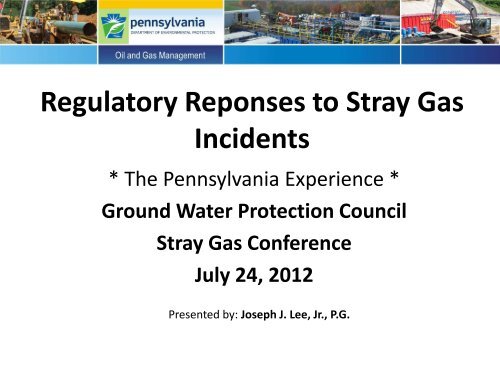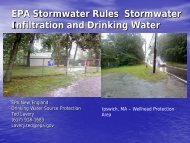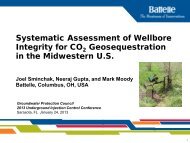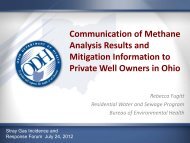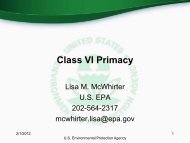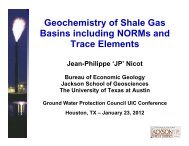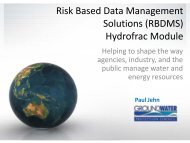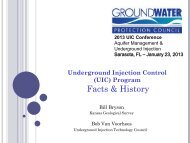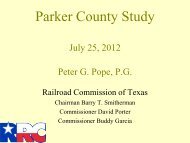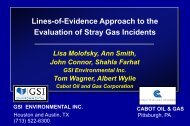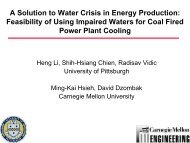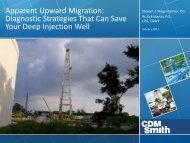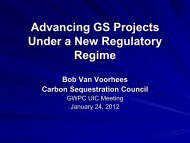Joe Lee - Groundwater Protection Council
Joe Lee - Groundwater Protection Council
Joe Lee - Groundwater Protection Council
You also want an ePaper? Increase the reach of your titles
YUMPU automatically turns print PDFs into web optimized ePapers that Google loves.
Regulatory Reponses to Stray Gas<br />
Incidents<br />
* The Pennsylvania Experience *<br />
Ground Water <strong>Protection</strong> <strong>Council</strong><br />
Stray Gas Conference<br />
July 24, 2012<br />
Presented by: Joseph J. <strong>Lee</strong>, Jr., P.G.
PA HISTORY RESOURCE DEVELOPMENT
Regulatory Control of Stray Gas Incidents<br />
>2007 HISTORY RESOURCE<br />
Prevention – Surveillance - Response<br />
DEVELOPMENT<br />
• Identification of deepest fresh ground water<br />
• Casing & cementing standards<br />
• Pre-drill surveys<br />
• Emergency response plans<br />
• Water supply replacement requirements<br />
• Investigation protocols & monitoring<br />
• Mechanical integrity testing, bonding logs<br />
• Remediation
Final Rulemaking 25 Pa. Code Chapter 78<br />
Background<br />
• Initial draft presented to TAB September 17, 2009<br />
‣ DEP met with TAB and subcommittee four additional times<br />
(10/28/09, 1/14/10, 1/21/10, 3/25/10)<br />
• Advanced Notice of Proposed Rulemaking: Public<br />
comment period January 30, 2010 – March 2, 2010<br />
• Notice of Final Rulemaking: Public comment period<br />
July 10, 2010 – August 9, 2010<br />
• Approval by EQB, IRRC, Attorney General’s Office.<br />
• Final Regulations approved on publication in the<br />
Pennsylvania Bulletin February 5, 2011
Chapter 78 Major Changes to Well Construction and<br />
Cementing and Other Changes to Subchapter D<br />
• Revised casing standards<br />
• New requirement for<br />
casing and cementing plan<br />
• New Section on lost<br />
circulation<br />
• Revised cement standards<br />
• New Section on<br />
mechanical integrity of<br />
existing wells
78.83. Surface and Coal Protective Casing and<br />
Cementing Procedures: New Language<br />
• Surface casing set depth: may not be set more than 200 feet<br />
below the deepest fresh groundwater except as necessary to set<br />
the casing in consolidated rock (Two string vs. three string)<br />
• Surface casing hole must be drilled using air, freshwater, or<br />
freshwater-based drilling fluid<br />
• Wellbore conditioning required<br />
• Centralizers now required: surface casing- at least one within 50<br />
ft. of the surface casing seat, then in intervals no greater than<br />
every 150 ft. above the first centralizer<br />
• Coal protective string must have at least two centralizers, one<br />
within 50 ft. of the casing seat and the second within 100 ft. of<br />
the surface<br />
• Intermediate and production casing centralizers required (DEP<br />
does not prescribe number and placement)
78.75a. New Section: Area of Alternative Methods<br />
• DEP may designate an area of alternative methods if it<br />
determines that well drilling and operating requirements<br />
beyond those provided in this Chapter are necessary<br />
• Notice of proposed area of alternative methods<br />
published in PA Bulletin<br />
• Wells drilled within this area must meet the<br />
requirements specified by the Department unless the<br />
operator obtains DEP approval to drill, operate or plug<br />
the well in a different manner that is at least as safe and<br />
protective of the environment as the requirements in the<br />
area of alternative methods
78.89. Stray Gas Mitigation Response<br />
• Establishes protocol for operator, DEP,<br />
and local emergency response<br />
agencies to determine the nature of a<br />
gas migration incident, assess the<br />
potential for hazards to public health<br />
and safety, and mitigate any hazard<br />
posed by the release of natural gas<br />
• Operator, in conjunction with the<br />
Department and local emergency<br />
response agencies, must take<br />
measures necessary to ensure public<br />
health and safety
Section 78.89: Gas Migration Response<br />
•A three-tiered approach<br />
Category 1 (Immediate Threat): detectable concentrations equal to or<br />
greater than 10% of the lower explosive limit (LEL) or combustible gas in a<br />
building or structure(s), or otherwise deemed Category 1 by the Department.<br />
Category 2 (Potential Threat): detectable concentrations less than<br />
10% of the LEL of combustible gas in a building or structure(s), and/or<br />
combustible gas greater than 50% of the LEL in the headspace of a water well,<br />
and/or visual or audible evidence of stray gas bubbling through a water well<br />
column or surface body, and/or detectable concentrations of stray gas in the<br />
soils, and/or concentrations of dissolved methane in water at or above 25% of<br />
the lower solubility limit for methane (7 mg/l).<br />
Category 3 (No Apparent Threat): none of the above conditions were<br />
met. If conditions indicate methane in groundwater at concentrations above 0.5<br />
mg/l, but below 7 mg/l, continued monitoring is necessary to ensure that<br />
concentrations do not trend to a Category 2 potential threat.
Other Responses<br />
• Workgroup on Casing & Cementing<br />
• Workgroup on DFGW<br />
• Building expertise<br />
• Training & Resources
Joseph J. <strong>Lee</strong>, Jr.<br />
Pennsylvania Department of Environmental<br />
<strong>Protection</strong><br />
Bureau of Oil & Gas Program Planning &<br />
Management<br />
(717)772-2199<br />
joslee@pa.gov


